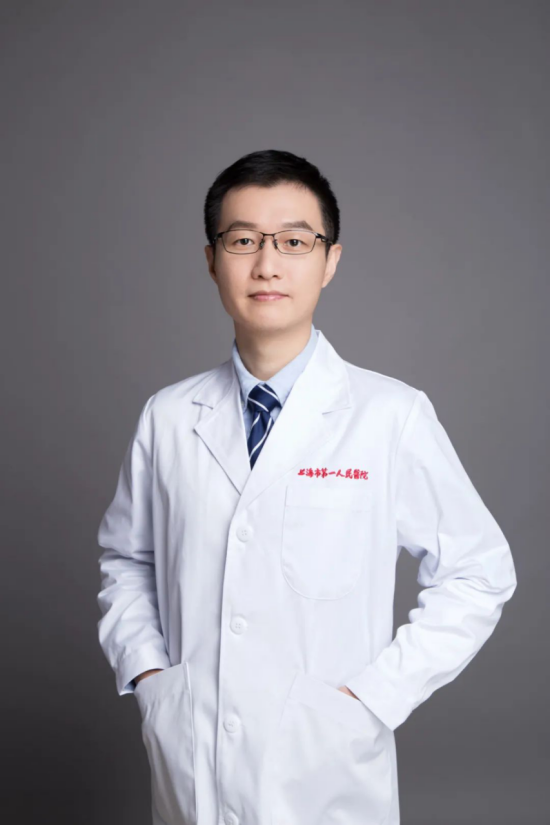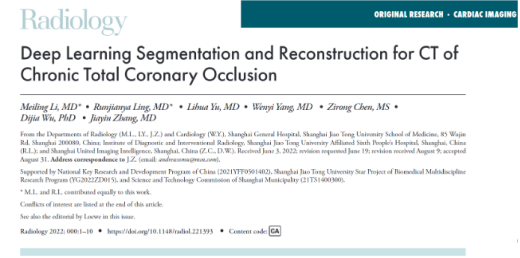- News
Why Did Radiology, A Top Medical Imaging Journal with Impact Factor of 29, Publish This AI Coronary CTO Reconstruction Article?
Link of the Original Article:
http://https://mp.weixin.qq.com/s/VFhEiE_KxkOyV2-4EojA0Q
Many researchers are engaged in the cardiovascular AI, but coronary CTO reconstruction is difficult and AI products see low success. How did this study, published in Radiology, make a breakthrough?
Recently, a research paper on automated coronary CTO AI reconstruction, "Deep Learning Segmentation and Reconstruction for CT of Chronic Total Coronary Occlusion", was published in the journal Radiology.
Radiology is a top journal on medical imaging, and its impact factor was 29.1 in 2022. The research results published in Radiology shows that the achievements are highly recognized by the radiologist experts worldwide.
Shanghai General Hospital, the major institute in this research, is one of the first hospitals in China to establish a medical imaging department, and radiology department in 1946. Artificial intelligence + cardiothoracic imaging is a key research direction of Radiology Department of Shanghai General Hospital, and the research on coronary CTO AI automatic reconstruction, led by Prof. Zhang Jiayin, director of the radiology department of the hospital, is one of the research projects conducted by the hospital in the cardiovascular field.
Cardiovascular has always been an important area of AI layout in medical imaging, but coronary CTO reconstruction is difficult, and there is not many successful AI products emerged. It is reported that the algorithm jointly researched by United Imaging Intelligence and Shanghai General Hospital can contribute to a success rate of 95% in automatic reconstruction of coronary CTO.
What is special about the algorithm applied in this study? How to solve the problem of automatic coronary CTO reconstruction? What other research directions are worth investing concerning cardiovascular AI? Focusing on these issues, Lei Feng.com held a dialogue with Prof. Zhang Jiayin, Director of Radiology Department at Shanghai General Hospital.

Prof. Zhang Jiayin
"Secret" of high success rate of coronary CTO reconstruction
Coronary CTO (Chronic Total Occlusion), that is, chronic complete occlusive lesions of the coronary arteries, is one of the most challenging lesion types in coronary interventional treatment.
According to the "China Cardiovascular Health and Disease Report 2021", the number of patients with coronary heart disease in China has exceeded 11.39 million, and the prevalence and mortality rate of coronary heart disease have increased year by year. In patients undergoing invasive coronary angiography (ICA), about 20% to 25% of cases are diagnosed coronary CTO lesions.
In clinical practice, coronary CT angiography (coronary CTA) is currently used as a non-invasive method to assess coronary disease, but the recognition and reconstruction of coronary CTO still needs to be manually drawn by doctors based on experience.
As early as 2013~2014, Prof. Zhang Jiayin paid close attention to the complex lesion of coronary CTO, and published a total of 3 papers related to coronary CTO lesions in the journal Radiology, explaining the imaging diagnosis, guiding treatment and evaluating lateral branch anatomy of coronary CTO.
Prof. Zhang Jiayin introduced that without ICA, CTO lesions are often not well identified on CT imaging. The doctor can only simulate the growth of blood vessels through the post-processing workstation, manually delineate the occluded segment and the collateral vessels at the distal end of the occlusion, and then perform the necessary measurements, including length, calcification load, and negative remodeling.
"The traditional identification of coronary CTO requires huge clinical manpower and time costs." Prof. Zhang Jiayin said that normally, it takes doctors more than ten minutes to complete a coronary CTO reconstruction.
To solve the problem, Prof. Zhang Jiayin and Lianying Imaging Intelligent team cooperated in the first half of last year to carry out the automatic reconstruction of coronary CTO AI based on deep learning algorithms. Although it took less than a year and a half to submit the project, the study was actually quite challenging.
Due to the weak development of the total occluded segment of the coronary artery, it is easy to cause blood vessel segmentation and incomplete rupture during the reconstruction process, and the requirements for the algorithm are high.

To this end, the researchers integrated the anatomy of coronary artery and heart into the algorithm, provided context information for coronary segmentation, and combined the local and overall characteristics of coronary artery to ensure the completeness, accuracy and continuity of coronary segmentation, especially the unclear CTO position segmentation.
In the end, the two teams performed reconstruction experiments on 240 CTO lesions in 211 patients. The experimental results show that the success rate of the algorithm in automatic segmentation and reconstruction is 95%, while the success rate of traditional workstations is only 48%. In terms of post-processing time, the algorithm can shorten the reconstruction time by up to 80%, and the result can be obtained in 2 to 3 minutes.
At present, the research results have been put into clinical use in the radiology department in Shanghai General Hospital. Prof. Zhang Jiayin said that in practical applications, it was found that AI has a good reconstruction effect on the distal end of the coronary CTO of 1mm and the small branches below 1mm, and can almost automatically identify, segment and label the entire occlusion segment, as well as the distal collateral blood vessels occluded, "The image effect is even better than that of human manual."
He believes the research will play a great role in promoting the accurate evaluation of preoperative images of clinical coronary CTOs. He hopes that in the future, this set of coronary reconstruction algorithms can be introduced to cardiac catheterization laboratories as well, so as to help the department of Cardiology to diagnose and make decisions.
